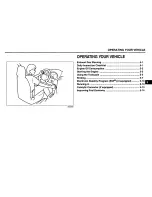Scanning the Terrain
Off-road driving can take you over many different kinds of
terrain. You need to be familiar with the terrain and its
many different features. Here are some things to
consider.
Surface Conditions: Off-roading can take you over
hard-packed dirt, gravel, rocks, grass, sand, mud, snow
or ice. Each of these surfaces affects the steering,
acceleration and braking of your vehicle in different
ways. Depending upon the kind of surface you are on,
you may experience slipping, sliding, wheel spinning,
delayed acceleration, poor traction and longer braking
distances.
Surface Obstacles: Unseen or hidden obstacles can
be hazardous. A rock, log, hole, rut or bump can startle
you if you’re not prepared for them. Often these
obstacles are hidden by grass, bushes, snow or even
the rise and fall of the terrain itself. Here are some
things to consider:
•
Is the path ahead clear?
•
Will the surface texture change abruptly up ahead?
•
Does the travel take you uphill or downhill?
(There’s more discussion of these subjects later.)
•
Will you have to stop suddenly or change direction
quickly?
When you drive over obstacles or rough terrain, keep a
firm grip on the steering wheel. Ruts, troughs or
other surface features can jerk the wheel out of your
hands if you’re not prepared.
When you drive over bumps, rocks, or other obstacles,
your wheels can leave the ground. If this happens,
even with one or two wheels, you can’t control
the vehicle as well or at all.
Because you will be on an unpaved surface, it’s
especially important to avoid sudden acceleration,
sudden turns or sudden braking.
In a way, off-road driving requires a different kind of
alertness from driving on paved roads and highways.
There are no road signs, posted speed limits or
signal lights. You have to use our own good judgment
about what is safe and what isn’t.
Drinking and driving can be very dangerous on any
road. And this is certainly true for off-road driving.
At the very time you need special alertness and driving
skills, your reflexes, perceptions and judgment can
be affected by even a small amount of alcohol.
You could have a serious — or even fatal — accident if
you drink and drive or ride with a driver who has
been drinking. See
Drunken Driving on page 4-4.
4-19
Summary of Contents for 2003 tracker
Page 5: ...These are some examples of vehicle symbols you may find on your vehicle v ...
Page 6: ... NOTES vi ...
Page 19: ...Put someone on it Get it up to speed Then stop the vehicle The rider doesn t stop 1 13 ...
Page 114: ...Instrument Panel Overview 3 2 ...
Page 156: ... NOTES 3 44 ...
Page 216: ... NOTES 4 60 ...
Page 230: ...When you open the hood on the 2 5L engine if equipped you ll see 5 14 ...
Page 312: ... NOTES 5 96 ...
Page 345: ...Maintenance Record cont d Date Odometer Reading Serviced By Maintenance Record 6 33 ...
Page 346: ...Maintenance Record cont d Date Odometer Reading Serviced By Maintenance Record 6 34 ...


















